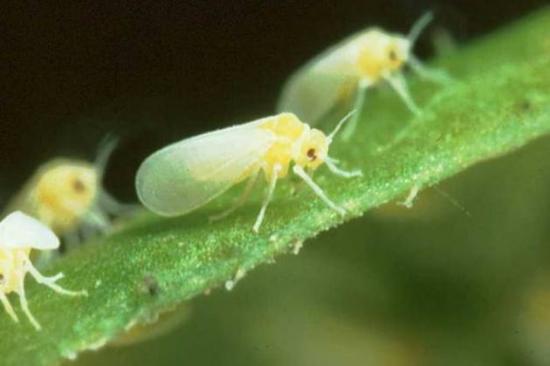美国一项最新研究发现,利用本瓜植物载体天敌系统可以有效生物防治大棚蔬菜(番茄)关键害虫烟粉虱,减少农药应用。这一研究成果公布在国际著名期刊《生物防治》(Biological Control)期刊上。
领导这一研究团队的是美国佛罗里达大学Lance Osborne教授,主持这一专项研究,也是研究报告第一作者肖英方博士。主要研究方向包括害虫生态行为调控,设施农业害虫生物防治理论和方法创新。
烟粉虱 (Bemisia tabaci (Gennadius)) 原发于热带和亚热带区,现在世界各地广泛传播并暴发成灾,现已成为各国蔬菜生产上,特别是温室蔬菜重要入侵害虫。烟粉虱的幼虫和成虫通过摄取植物汁液直接危害寄主植物,还可以传播110多种植物病毒,分泌蜜露诱发霉污病影响光合作用,导致蔬菜减产,品质下降。目前百分之百的依赖农药,由于化学农药引起抗药性和民众对食品安全的担忧。
研究人员发现,本瓜载体植物天敌系统(Banker plant system),是生物防治新理念,可有效生物防治温室害虫烟粉虱。研究人员通过研究,建立了本瓜载体植物天敌系统。这个防治系统有三部分组成:1. 本瓜植物 (载体);2. 很强专化性的非害虫粉虱,只能寄生在本瓜植物;3. 一个具有很强取食,寄生和扩散能力的寄生蜂,能同时寄生在烟粉虱和本瓜粉虱两个寄主上。这个系统优点是,第一,可以在温室或大棚大量自主繁衍寄生蜂,然后这个寄生蜂扩散到番茄或豆类作物的害虫烟粉虱上取食和寄生。该系统不依赖商业化寄生蜂,节省成本;第二,引进本瓜粉虱进入大棚或温室不会对番茄或豆类作物造成为害,没有潜在风险;第三,在必要时,可以灵活应用杀虫剂。因为本瓜载体植物可以暂时移出大棚或温室,不会杀伤这个寄生蜂,达到综合防治害虫的目的。大大减少农药使用和烟粉虱为害。此外,本瓜载体植物天敌系统还可以存载多种天敌。目前,此系统已在大棚蔬菜生产中包括番茄,黄瓜,茄子,生菜,圣诞花一品红和中草药 生产中应用,取得明显成效。

烟粉虱
生物探索推荐英文摘要
Establishment of papaya banker plant system for parasitoid, Encarsia sophia (Hymenoptera
Abstract: The silverleaf whitefly, Bemisia tabaci biotype B (Gennadius) (Hemiptera: Aleyrodidae), is a key pest of tomato (Solanum lycopersicum L.) and other vegetable crops worldwide. To combat this pest, a non-crop banker plant system was evaluated that employs a parasitoid, Encarsia sophia (Girault & Dodd) (Hymenoptera: Aphelinidae) with whitefly, Trialeurodes variabilis (Quaintance) (Hemiptera: Aleyrodidae), as an alternative host for rearing and dispersal of the parasitoid to the target pest. Multi-choice and no-choice greenhouse experiments were conducted to determine host specificity of T. variabilis to papaya (Carica papaya L.) and three vegetable crops including tomato, green bean (Phaseolus vulgaris L.), and cabbage (Brassica oleracea L.). The result showed that papaya was an excellent non-crop banker plant for supporting the non-pest alternative host, T. variabilis, whose adults had a strong specificity to papaya plants for feeding and oviposition in both multi-choice and no-choice tests. The dispersal ability of E. sophia was investigated from papaya banker plants to tomato and green bean plants infested with B. tabaci, as well as to papaya control plants infested with T. variabilis; and the percent parasitism by E. sophia on T. variabilis reared on papaya plants and on B. tabaci infested on tomato plants was also evaluated. These data proved that E. sophia was able to disperse at least 14.5 m away from papaya plants to target tomato, bean or papaya control plants within 48–96 h. Furthermore, E. sophia was a strong parasitoid of both T. variabilis and B. tabaci. There was no significant difference in percent parasitism by E. sophia on T. variabilis (36.2–47.4%) infested on papaya plants or B. tabaci (29–45.9%) on tomato plants. Thus, a novel banker plant system for the potential management of B. tabaci was established using papaya as a non-crop banker plant to support a non-pest alternative host, T. variabilis for maintaining the parasitoid to control B. tabaci. The established banker plant system should provide growers with a new option for long-term control of B. tabaci in greenhouse vegetable production. Ongoing studies on the papaya banker plant system are being performed in commercial greenhouses.







